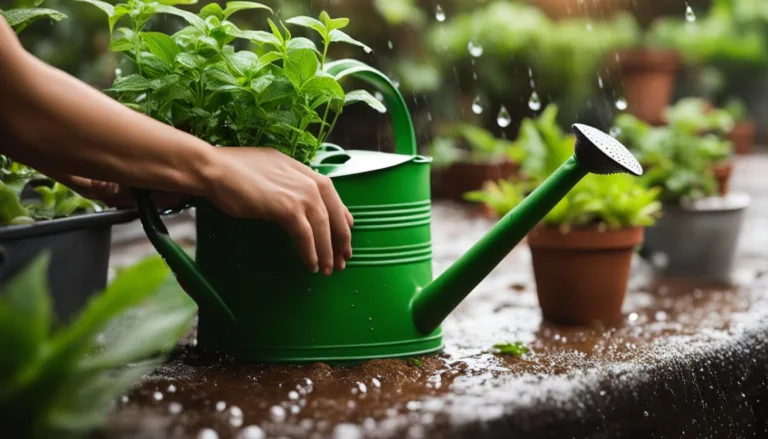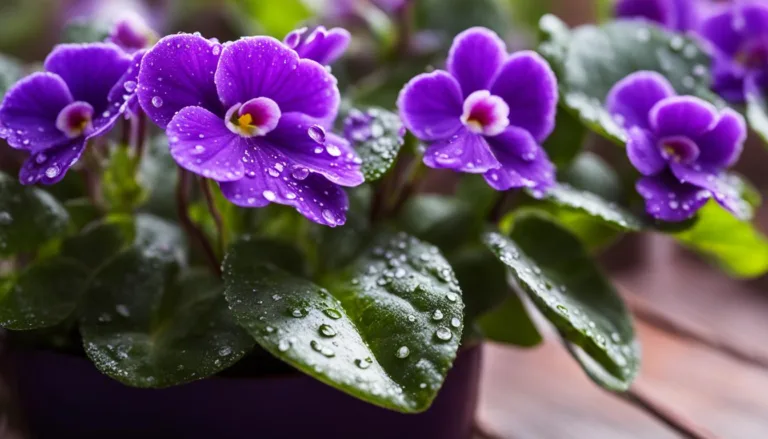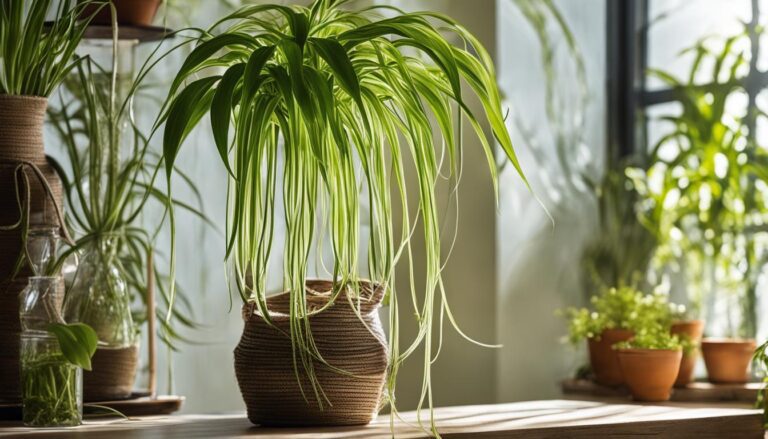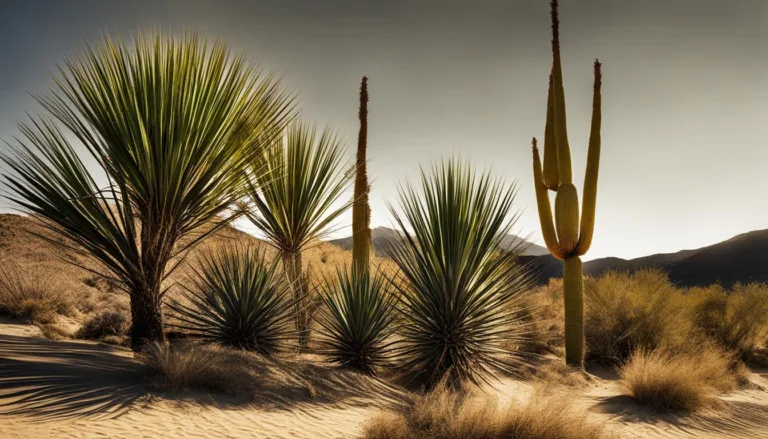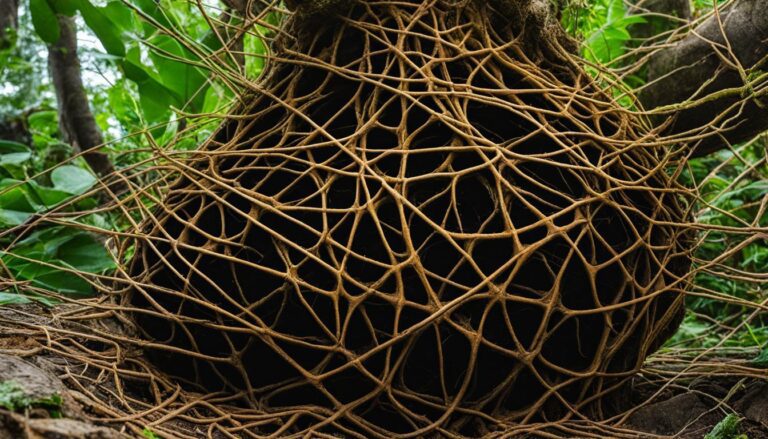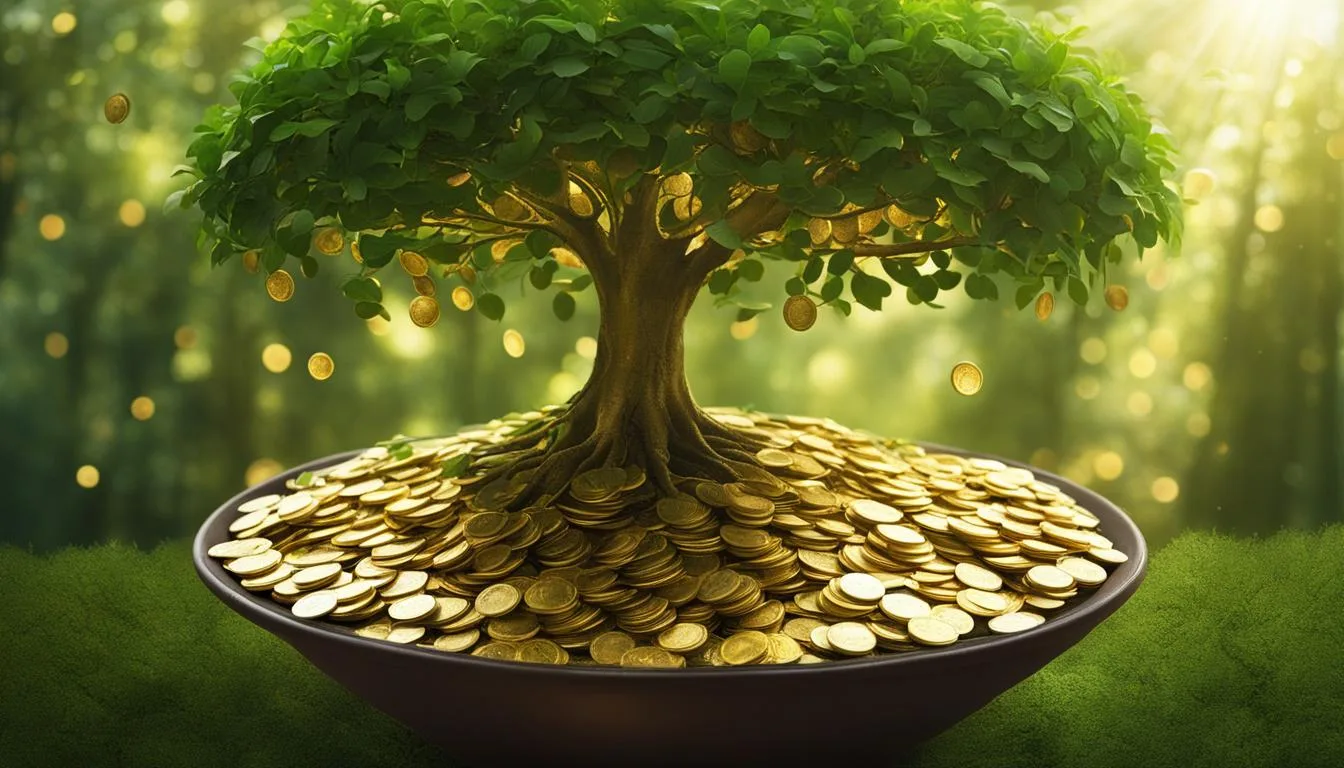
Welcome to my article on money tree care for financial growth! If you’re looking to bring some greenery into your space while also inviting good luck and financial success, the money tree, scientifically known as Pachira aquatica, is an excellent choice.
With its braided trunk and vibrant green leaves, the money tree not only adds a touch of natural beauty to your environment but is also believed to have positive symbolism across various cultures.
Throughout this article, I will provide you with valuable tips on caring for your money tree to promote financial growth. We’ll explore its origins, growing conditions, watering and soil requirements, propagation techniques, common problems and pest control, bonsai and training techniques, as well as tips for buying and caring for your money tree. By the end, you’ll have all the knowledge you need to ensure the long and happy life of your money tree!
Key Takeaways:
- Proper care of a money tree can promote financial growth and bring good luck.
- The money tree has a braided trunk and lively green leaves, making it an attractive addition to any space.
- Money trees prefer bright, indirect light and moderate-to-high humidity conditions.
- Water the money tree when the top 2-4 inches of soil are dry, ensuring good drainage to prevent root rot.
- Money trees can be propagated through stem cuttings and maintained through regular pruning.
Now, let’s dive into the fascinating world of money tree care and discover all the secrets behind nurturing this remarkable plant for financial growth!
The Origins and Symbolism of the Money Tree
The money tree, scientifically known as Pachira aquatica, is a fascinating plant with origins in the swamps of Central and South America. This tropical plant can grow up to an impressive height of 60 feet. However, the unique braided trunk that is often associated with money trees is not a natural occurrence.
It is a result of careful cultivation by growers who braid and intertwine the trunks of multiple young plants. This technique gives the money tree its distinctive appearance, making it an attractive addition to any space.
Symbolism plays a significant role in the popularity of the money tree. The tree is believed to bring good luck and financial success in various cultures around the world. The braided trunk is thought to symbolize the weaving together of energy and luck, creating a positive flow of prosperity.
By having a money tree in your home or office, you invite the potential for wealth and abundance into your life. Even if you don’t subscribe to the symbolic meanings, the money tree still stands as a visually appealing and low-maintenance plant.
Whether you believe in the symbolism or not, the money tree can serve as a beautiful reminder to nurture your own financial growth. Its vibrant green leaves bring a sense of nature indoors, adding freshness and vitality to any space.
As you care for your money tree, remember to provide it with the right light, temperature, and humidity. With proper care, your money tree can thrive and bring an aesthetic and financial boost to your life.
Growing Conditions for the Money Tree
In order to ensure the proper growth and development of your money tree, it’s essential to provide the right growing conditions. This section will cover the light, humidity, temperature, and location requirements that are necessary for the optimal health of your money tree.
Light
The money tree thrives best in bright, indirect light. It is important to avoid placing it in direct sunlight as this can lead to sunburn on the leaves. If your money tree is not receiving enough light, it may become leggy and its growth may slow down.
On the other hand, if it is exposed to too much light, it can result in leaf burn. Finding the right balance of light is key to ensuring the well-being of your money tree.
Humidity
Money trees prefer moderate-to-high humidity levels to thrive. In environments with low humidity, it is important to take steps to increase humidity levels around the plant.
One way to do this is by using a pebble tray. Simply fill a tray with water and place pebbles on top, then position your money tree on the pebbles. As the water evaporates, it will create a more humid environment around the plant.
Temperature and Location
The ideal temperature range for money trees is between 65 and 85 degrees Fahrenheit. It is important to avoid exposing your money tree to sudden temperature fluctuations or drafts, as this can cause stress and lead to leaf drop.
It’s best to keep your money tree away from air conditioning vents or radiators, as these can create unfavorable conditions for the plant. Finding a warm and stable location in your home will provide the optimum temperature and prevent any unwanted stress on your money tree.
| Light | Humidity | Temperature | Location |
|---|---|---|---|
| Bright, indirect light | Moderate-to-high humidity | 65 to 85 degrees Fahrenheit | Avoid drafts and sudden temperature changes |
Watering and Soil Requirements for the Money Tree
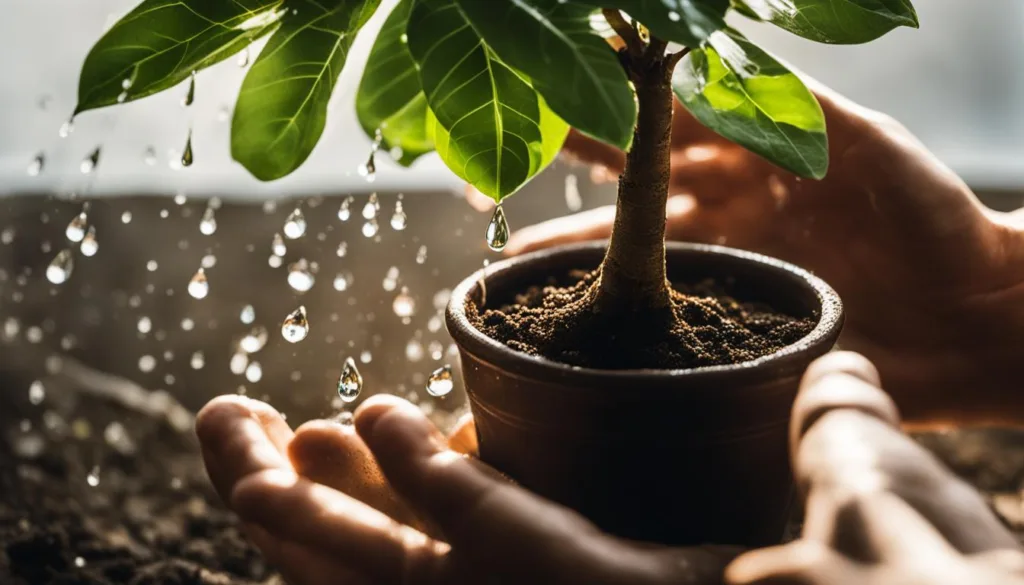
Proper watering and soil conditions are essential for the health and growth of your money tree. Let’s take a closer look at how to water your money tree and the type of soil it thrives in.
Watering:
The key to watering your money tree is to allow the top 2-4 inches of soil to dry out before watering again. Overwatering can lead to root rot and other health issues, so it’s important not to let the soil stay wet for too long.
Use your finger or a moisture meter to check the moisture level of the soil before deciding to water. When it’s time to water, thoroughly saturate the soil until water drains out of the bottom of the pot. Remember to empty any excess water from the saucer to prevent soggy soil.
Soil Requirements:
The ideal soil for a money tree is sandy and well-draining. This type of soil allows excess water to flow through, preventing waterlogged conditions that can harm the roots. You can create a suitable soil mix by combining regular potting soil with sand or perlite to enhance drainage.
Avoid using heavy soils that retain too much moisture, such as clay-based soils. Good drainage is crucial for the overall health and longevity of your money tree.
By ensuring proper watering and providing well-draining soil, you can create an optimal environment for your money tree to thrive. Remember to monitor the moisture level of the soil and adjust your watering schedule accordingly. With the right care, your money tree will continue to bring beauty and financial growth to your space.
| Watering Tips for Money Trees | Soil Requirements for Money Trees |
|---|---|
|
|
Propagation of the Money Tree
Propagating money trees can be a rewarding experience and a great way to expand your collection. One of the most common methods of propagation is through stem cuttings.
To propagate a money tree through stem cuttings, start by selecting a healthy stem with at least two leaf nodes. Using a sharp, clean pair of pruning shears, make a clean cut just below a leaf node.
Once you have your stem cutting, dip the cut end into rooting hormone to encourage root development. Then, plant the cutting in a well-draining potting mix, making sure to bury at least one node in the soil. Keep the soil consistently moist and provide adequate humidity by covering the cutting with a clear plastic bag or placing it in a propagator.
It usually takes around 4 weeks for the cutting to develop roots. During this time, mist the cutting regularly to maintain humidity and avoid overwatering.
Once roots have formed, you can gradually acclimate the new plant to its growing conditions by removing the plastic bag or propagator and gradually increasing light exposure. Remember to prune your money tree regularly to maintain its desired shape and size.
| Propagation Method | Difficulty Level | Success Rate |
|---|---|---|
| Stem Cuttings | Easy | High |
| Air Layering | Moderate | Medium |
| Division | Moderate | Low |
Table: Comparison of Money Tree Propagation Methods
Common Problems and Pest Control for Money Trees
While money trees are generally hardy and low-maintenance plants, they can still encounter some common problems. One of the most prevalent issues is overwatering. It’s important to allow the top 2-4 inches of soil to dry out before watering the plant again. Overwatering can lead to root rot and other complications.
Money trees can also be susceptible to pests such as scale insects, mealybugs, and aphids. These tiny creatures can feed on the plant’s sap and cause damage to the leaves. To control these pests, you can use systemic insect control or apply horticultural oil spray. Regular inspection and proper care can help prevent infestations and keep your money tree healthy.
Possible Problems and Solutions:
| Possible Problem | Solution |
|---|---|
| Overwatering | Allow the top 2-4 inches of soil to dry out before watering again. Ensure proper drainage to prevent root rot. |
| Scale Insects | Use systemic insect control or horticultural oil spray to treat scale insects. Regularly inspect the plant for signs of infestation. |
| Mealybugs | Apply horticultural oil spray or use natural remedies like neem oil or rubbing alcohol to eliminate mealybugs. Remove any heavily infested plant parts. |
| Aphids | Use a strong jet of water or an insecticidal soap spray to control aphids. Regularly monitor the plant for any signs of aphid activity. |
By addressing these common problems and promptly implementing the appropriate solutions, you can maintain the health and vitality of your money tree.
Regular care, including proper watering and pest control, will ensure that your plant continues to thrive and bring beauty and good luck to your space. Remember to inspect your money tree regularly to catch any issues early on and take proactive steps to address them.
Money Tree Bonsai and Training Techniques

I have always been fascinated by the art of bonsai, and when it comes to money trees, the possibilities are endless. Bonsai is the practice of growing a miniature tree in a small container and training it to adopt a specific shape.
Money trees are often sold as bonsai with their distinctive braided trunks or twisted forms, making them an excellent choice for bonsai enthusiasts.
Training a money tree bonsai requires patience and attention to detail. To maintain the desired shape and size, sturdy string or wire can be used to bind the trunks together tightly.
This will encourage the trunks to grow in the desired direction. Regular pruning is also essential to remove unwanted growth and maintain the bonsai’s aesthetic appeal.
When training a money tree bonsai, it’s important to remember that the process takes time. The tree will need consistent care and regular monitoring to ensure that it thrives in its bonsai form.
By following proper training techniques and giving the tree the care it needs, you can create a stunning and unique money tree bonsai that will be the envy of any bonsai enthusiast.
Training Techniques for Money Tree Bonsai
There are several training techniques that can be used to shape and style a money tree bonsai. Some common techniques include:
- Wiring: By carefully wrapping wire around the branches, you can guide their growth and shape the tree.
- Pruning: Regular pruning helps control the size and shape of the bonsai. It also encourages the tree to develop a dense canopy.
- Leaf trimming: Removing some of the larger leaves can help create a more balanced and aesthetic appearance.
- Root pruning: Periodically repotting the bonsai and trimming its roots helps promote overall health and encourages the growth of finer feeder roots.
Combining different techniques and experimenting with various styles can result in a truly unique money tree bonsai that reflects your personal taste and creativity.
Buying and Caring for a Money Tree
If you’re looking to bring some good luck and financial growth into your home, a money tree (Pachira aquatica) could be just the plant for you. With its braided trunk and lush green leaves, this popular houseplant not only adds a touch of beauty to any space but also symbolizes prosperity and good fortune.
When buying a money tree, it’s important to choose a healthy plant with vibrant green foliage. Look for leaves that are free from yellowing or browning, as this could be a sign of stress or improper care. If possible, check the roots to ensure they are firm and white, indicating a well-established and healthy plant.
Once you bring your money tree home, it’s essential to provide it with the right care to ensure its long-term health and growth. Here are a few tips to keep in mind:
1. Light and Location:
- Place your money tree in a spot that receives bright, indirect light. Avoid placing it in direct sunlight, as this can scorch the leaves.
- Keep in mind that money trees can tolerate low light conditions, but they may become leggy and less vibrant.
2. Watering and Humidity:
- Water your money tree when the top 2-4 inches of soil are dry. Overwatering can lead to root rot, so it’s important to let the soil dry out slightly between waterings.
- Maintain moderate-to-high humidity levels around your money tree by using a pebble tray or regularly misting the leaves.
3. Fertilizing and Pruning:
- Fertilize your money tree with a balanced liquid plant food once a month during the growing season (spring and summer). Avoid fertilizing during winter months when the plant is dormant.
- Prune your money tree to maintain its desired shape and size. Regular pruning also helps promote branching and a fuller appearance.
Remember, money trees are non-toxic to pets, making them a great choice for households with furry friends. However, it’s still a good idea to keep your money tree out of reach of any curious nibblers to prevent any potential tummy upsets.
By following these care tips, your money tree will not only bring beauty and charm to your space but also have the potential to attract good luck and financial growth. Happy planting!
After exploring the various aspects of money tree care, it’s clear that this plant is not only visually appealing but also holds the promise of financial growth. While it may not literally produce money, the money tree’s symbolism and low-maintenance nature make it a worthwhile addition to any space.
By following the maintenance tips outlined in this article, you can ensure the longevity and vibrancy of your money tree. Providing the right amount of light, avoiding overwatering, and maintaining proper humidity are key factors in its care. Remember to prune and shape the tree as needed to keep it looking its best.
Whether you believe in the symbolism of the money tree or simply enjoy its unique beauty, this plant has the potential to enhance your surroundings and bring a sense of financial positivity. So why not invest in a money tree today and enjoy the benefits it can bring to your space?
FAQ
Can money trees grow up to 60 feet tall naturally?
No, the braided trunk of the money tree is not natural and is created by cultivators.
Are money trees actually believed to bring good luck and financial success?
Yes, the money tree is believed to bring good luck and financial success due to its symbolism in various cultures.
How much light do money trees need?
Money trees prefer bright, indirect light but can tolerate low light conditions. Direct sunlight should be avoided.
What should the temperature be for money trees?
Money trees thrive in temperatures between 65 and 85 degrees Fahrenheit, avoiding sudden temperature shifts.
How often should money trees be watered?
Money trees should be watered when the top 2-4 inches of soil are dry, usually about once a week.
What type of soil is best for money trees?
Money trees prefer sandy soil with good drainage to avoid root rot.
Can money trees be propagated?
Yes, money trees can be propagated by taking stem cuttings with at least two leaf nodes.
What are common problems and pests that affect money trees?
Money trees can be affected by overwatering, too much sunlight, scale insects, mealybugs, and aphids.
Can money trees be trained as bonsai?
Yes, money trees are often sold as bonsai with braided or twisted trunks and can be maintained in the desired shape using training techniques.
Are money trees toxic to pets?
No, money trees are not toxic to pets but should be kept away from nibblers to prevent any tummy upset.


